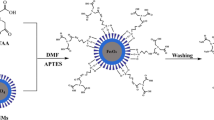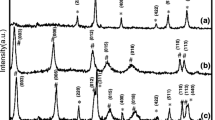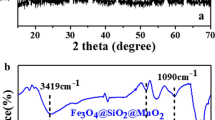Abstract
The development and utilization of magnetic nanoadsorption materials with large adsorption capacity and easy separation are the research hotspot nowadays. In this study, nanosheet-assembled maghemite (γ-Fe2O3) magnetic microspheres were successfully synthesized by an environmental friendly, quick, and simple method, for enhanced Sb(III) removal from aqueous solution. Scanning electron microscopy (SEM), X-ray diffraction (XRD), X-ray photoelectron spectroscopy (XPS), vibrating sample magnetometer (VSM), and Brunauer-Emmett-Teller (BET) were used to characterize the material. The results showed that the product contained flower-like γ-Fe2O3 microspheres composed of petal-shaped nanosheets interspersed with each other. The specific surface area and pore volume were 69.23 m2/g and 0.15 cm3/g, respectively. The material has a strong magnetic response, which allows rapid solid-liquid separation under the action of an external magnetic field. The effects of different dosages, solution pH, and contact time on the adsorption effect were studied by batch adsorption experiments, and the reusability of the materials was evaluated. Both Freundlich isothermal adsorption model and pseudo-second-order kinetic model were able to describe the uptake of Sb(III). The maximum adsorption capacity of the material was 47.48 mg/g under optimal conditions. The adsorption mechanism is mainly that Sb and lattice oxygen (OX2−) form Fe-O-Sb coordination bonds, which is incorporated into the crystal structure of γ-Fe2O3 as inner-sphere surface complexes. The synthetic material has the advantage of simple preparation process, good adsorption capacity, operation over a wide range of pH, and easy physical separation from treatment systems with good potential for future application to treat polluted wastewater.

















Similar content being viewed by others
Data availability
All data generated or analyzed during this study are included in this published article.
References
Abdullah NH, Shameli K, Abdullah EC, Abdullah LC (2019) Solid matrices for fabrication of magnetic iron oxide nanocomposites: synthesis, properties, and application for the adsorption of heavy metal ions and dyes. Compos Pt B-Eng 162:538–568. https://doi.org/10.1016/j.compositesb.2018.12.075
Acar FN, Malkoc E (2004) The removal of chromium(VI) from aqueous solutions by Fagus orientalis L. Bioresour Technol 94(1):13–15. https://doi.org/10.1016/j.biortech.2003.10.032
Ahmadi M, Hazrati Niari M, Kakavandi B (2017) Development of maghemite nanoparticles supported on cross-linked chitosan (γ-Fe2O3@CS) as a recoverable mesoporous magnetic composite for effective heavy metals removal. J Mol Liq 248:184–196. https://doi.org/10.1016/j.molliq.2017.10.014
Bulin C, Li B, Zhang Y, Zhang B (2020) Removal performance and mechanism of nano α-Fe2O3/graphene oxide on aqueous Cr(VI). J Phys Chem Solids 147:109659. https://doi.org/10.1016/j.jpcs.2020.109659
Chen H, Li T, Zhang L, Wang R, Jiang F, Chen J (2015) Pb(II) adsorption on magnetic γ-Fe2O3/titanate nanotubes composite. J Environ Chem Eng 3(3):2022–2030. https://doi.org/10.1016/j.jece.2015.07.010
Chowdhury SR, Yanful EK, Pratt AR (2012) Chemical states in XPS and Raman analysis during removal of Cr(VI) from contaminated water by mixed maghemite–magnetite nanoparticles. J Hazard Mater 235-236:246–256. https://doi.org/10.1016/j.jhazmat.2012.07.054
Fiore M, Longoni G, Santangelo S, Pantò F, Stelitano S, Frontera P, Antonucci P, Ruffo R (2018) Electrochemical characterization of highly abundant, low cost iron (III) oxide as anode material for sodium-ion rechargeable batteries. Electrochim Acta 269:367–377. https://doi.org/10.1016/j.electacta.2018.02.161
Flak D, Chen Q, Mun BS, Liu Z, Rękas M, Braun A (2018) In situ ambient pressure XPS observation of surface chemistry and electronic structure of α-Fe2O3 and γ-Fe2O3 nanoparticles. Appl Surf Sci 455:1019–1028. https://doi.org/10.1016/j.apsusc.2018.06.002
Ge J, Hu Y, Biasini M, Beyermann W, Yin Y (2007) Superparamagnetic magnetite colloidal nanocrystal clusters. Angew Chem Int Edit 119(23):4420–4423. https://doi.org/10.1002/ange.200700197
Georgieva VG, Gonsalvesh L, Tavlieva MP (2020) Thermodynamics and kinetics of the removal of nickel (II) ions from aqueous solutions by biochar adsorbent made from agro-waste walnut shells. J Mol Liq 312:112788. https://doi.org/10.1016/j.molliq.2020.112788
Guo X, Wu Z, He M, Meng X, Jin X, Qiu N, Zhang J (2014) Adsorption of antimony onto iron oxyhydroxides: adsorption behavior and surface structure. J Hazard Mater 276(15):339–345. https://doi.org/10.1016/j.jhazmat.2014.05.025
Guo W, Fu Z, Wang H, Sha L, Wu F, Giesy JP (2018) Removal of antimonate (Sb(V)) and antimonite (Sb(III)) from aqueous solutions by coagulation-flocculation-sedimentation (CFS): dependence on influencing factors and insights into removal mechanisms. Sci Total Environ 644:1277–1285. https://doi.org/10.1016/j.scitotenv.2018.07.034
Gusain R, Kumar N, Ray SS (2020) Recent advances in carbon nanomaterial-based adsorbents for water purification. Coord Chem Rev 405:213111. https://doi.org/10.1016/j.ccr.2019.213111
Hao Y, Man C, Hu Z (2010) Effective removal of Cu (II) ions from aqueous solution by amino-functionalized magnetic nanoparticles. J Hazard Mater 184(1-3):392–399. https://doi.org/10.1016/j.jhazmat.2010.08.048
Hao H, Liu G, Wang Y, Shi B, Han K, Zhuang Y, Kong Y (2019) Simultaneous cationic Cu(II)–anionic Sb(III) removal by NH2-Fe3O4-NTA core-shell magnetic nanoparticle sorbents synthesized via a facile one-pot approach. J Hazard Mater 362:246–257. https://doi.org/10.1016/j.jhazmat.2018.08.096
He M, Wang N, Long X, Zhang C, Ma C, Zhong Q, Wang A, Wang Y, Pervaiz A, Shan J (2019) Antimony speciation in the environment: recent advances in understanding the biogeochemical processes and ecological effects. J Environ Sci 75:14–39. https://doi.org/10.1016/j.jes.2018.05.023
Jordan N, Ritter A, Scheinost A, Weiss S, Dieter S, René H (2014) Selenium(IV) uptake by maghemite (γ-Fe2O3). Environ Sci Technol 48(3):1665–1674. https://doi.org/10.1021/es4045852
Khosravi M, Azizian S (2014) Synthesis of different nanostructured flower-like iron oxides and study of their performance as adsorbent. Adv Powder Technol 25(5):1578–1584. https://doi.org/10.1016/j.apt.2014.05.010
Kirsch R, Scheinost AC, Rossberg A, Banerjee D, Charlet L (2008) Reduction of antimony by nano-particulate magnetite and mackinawite. Mineral Mag 72:185–189. https://doi.org/10.1180/minmag.2008.072.1.185
Leng Y, Guo W, Su S, Yi C, Xing L (2012) Removal of antimony(III) from aqueous solution by graphene as an adsorbent. Chem Eng J 211-212:406–411. https://doi.org/10.1016/j.cej.2012.09.078
Li M, Liu H, Zhu H, Gao H, Zhang S, Chen T (2017) Kinetics and mechanism of Sr(II) adsorption by Al-Fe2O3: evidence from XPS analysis. J Mol Liq 233:364–369. https://doi.org/10.1016/j.molliq.2017.03.045
Li J, Zheng B, He Y, Zhou Y, Chen X, Ruan S, Yang Y, Dai C, Tang L (2018a) Antimony contamination, consequences and removal techniques: a review. Ecotox Environ Safe. 156:125–134. https://doi.org/10.1016/j.ecoenv.2018.03.024
Li W, Fu F, Ding Z, Tang B (2018b) Zero valent iron as an electron transfer agent in a reaction system based on zero valent iron/magnetite nanocomposites for adsorption and oxidation of Sb(III). J Taiwan Inst Chem Eng 85:155–164. https://doi.org/10.1016/j.jtice.2018.01.032
Li J, Guo R, Ma Q, Nengzi L, Cheng X et al (2019) Efficient removal of organic contaminant via activation of potassium persulfate by γ-Fe2O3/α-MnO2 nanocomposite. Sep Purif Technol 227:115669. https://doi.org/10.1016/j.seppur.2019.06.007
Liu W, Ma J, Chen K (2015) Micron-size superparamagnetic iron-oxides watercress with unique MRI properties. Mater Chem Phys 170:123–128. https://doi.org/10.1016/j.matchemphys.2015.12.029
Ma X, Feng X, Song C, Zou B, Ding C, Yu Y, Chen C (2013) Facile synthesis of flower-like and yarn-like α-Fe2O3 spherical clusters as anode materials for lithium-ion batteries. Electrochim Acta 93:131–136. https://doi.org/10.1016/j.electacta.2013.01.096
Ma J, Zhou G, Chu L, Liu Y, Liu C, Luo S, Wei Y (2016) Efficient removal of heavy metal ions with EDTA functionalized chitosan/polyacrylamide double network hydrogel. ACS Sustain Chem Eng 5(1):843–851. https://doi.org/10.1021/acssuschemeng.6b02181
Ma Z, Shan C, Liang J, Tong M (2018) Efficient adsorption of Selenium(IV) from water by hematite modified magnetic nanoparticles. Chemosphere 193:134–141. https://doi.org/10.1016/j.chemosphere.2017.11.005
Mirbagheri NS, Sabbaghi S (2018) A natural kaolin/γ-Fe2O3 composite as an efficient nano-adsorbent for removal of phenol from aqueous solutions. Microporous Mesoporous Mat 259:134–141. https://doi.org/10.1016/j.micromeso.2017.10.007
Morin G, Ona-Nguema G, Wang Y, Menguy N, Brown GE (2008) Extended X-ray absorption fine structure analysis of arsenite and arsenate adsorption on maghemite. Environ Sci Technol 42(7):2361–2366. https://doi.org/10.1021/es072057s
Nishiyama SY, Saito K, Saito K et al (2003) High-speed recovery of antimony using chelating porous hollow-fiber membrane. J Membr Sci 214(2):275–281. https://doi.org/10.1016/S0376-7388(02)00558-6
Niu J, Zhang Z, Dai P, Yao B, Yu X, Zhang Q, Yang R (2018) Facile synthesis of γ-Fe2O3/BiOI microflowers with enhanced visible light photocatalytic activity. Mater Des 150:29–39. https://doi.org/10.1016/j.matdes.2018.04.001
Patra D, Gopalan B, Ganesan R (2019) Direct solid-state synthesis of maghemite as a magnetically recoverable adsorbent for the abatement of methylene blue. Journal of Environmental Chemical Engineering 7(5):103384. https://doi.org/10.1016/j.jece.2019.103384
Penki TR, Shivakumara S, Minakshi M, Munichandraiah N (2015) Porous flower-like α-Fe2O3 nanostructure: a high performance anode material for lithium-ion batteries. Electrochim Acta 167:330–339. https://doi.org/10.1016/j.electacta.2015.03.146
Pintor AMA, Vieira BRC, Boaventura RAR, Botelho CMS (2020) Removal of antimony from water by iron-coated cork granulates. Sep Purif Technol 233:116020. https://doi.org/10.1016/j.seppur.2019.116020
Piraman S, Sundar S, Mariappan R, Kim YY, Min K (2016) Nanospheres and nanoleaves of γ-Fe2O3 architecturing for magnetic and biomolecule sensing applications. Sens Actuator B-Chem. 234:386–394. https://doi.org/10.1016/j.snb.2016.04.168
Qi Z, Lan H, Prasai Joshi T, Liu R, Liu H, Qu J (2016) Enhanced oxidative and adsorptive capability towards antimony by copper-doping into magnetite magnetic particles. RSC Adv 6:66990–67001. https://doi.org/10.1039/C6RA13412B
Qi Z, Joshi TP, Liu R, Liu H, Qu J (2017) Synthesis of Ce(III)-doped Fe3O4 magnetic particles for efficient removal of antimony from aqueous solution. J Hazard Mater 329:193–204. https://doi.org/10.1016/j.jhazmat.2017.01.007
Ramirez-Muñiz K, Jia F, Song S (2012) Adsorption of As(V) in aqueous solutions on porous hematite prepared by thermal modification of a siderite-goethite concentrate. Environ Chem 9(6):512–520. https://doi.org/10.1071/EN12120
Ren B, Chen Y, Zhu G, Wang Z, Zheng X (2016) Spatial variability and distribution of the metals in surface runoff in a nonferrous metal mine. J Anal Methods Chem 7:1–11. https://doi.org/10.1155/2016/4515673
Ren B, Zhou Y, Ma H, Deng R, Zhang P, Hou B (2018) Sb release characteristics of the solid waste produced in antimony mining smelting process. J MATER CYCLES WASTE Manag 20:193–200. https://doi.org/10.1007/s10163-016-0562-4
Ren M, Ding S, Fu Z, Yang L, Tang W, Tsang DCW, Wang D, Wang Y (2019) Seasonal antimony pollution caused by high mobility of antimony in sediments: in situ evidence and mechanical interpretation. J Hazard Mater 367:427–436. https://doi.org/10.1016/j.jhazmat.2018.12.101
Ruan B, Wu P, Liu J, Jiang L, Wang H, Qiao J, Zhu N, Dang Z, Luo H, Yi X (2020) Adhesion of Sphingomonas sp. GY2B onto montmorillonite: a combination study by thermodynamics and the extended DLVO theory. Colloid Surf B-Biointerfaces 192:111085. https://doi.org/10.1016/j.colsurfb.2020.111085
Saleh TA, Sarı A, Tuzen M (2017) Effective adsorption of antimony(III) from aqueous solutions by polyamide-graphene composite as a novel adsorbent. Chem Eng J 307:230–238. https://doi.org/10.1016/j.cej.2016.08.070
Sarı A, Çıtak D, Tuzen M (2010) Equilibrium, thermodynamic and kinetic studies on adsorption of Sb(III) from aqueous solution using low-cost natural diatomite. Chem Eng J 162(2):521–527. https://doi.org/10.1016/j.cej.2010.05.054
Shan C, Ma Z, Tong M (2014) Efficient removal of trace antimony(III) through adsorption by hematite modified magnetic nanoparticles. J Hazard Mater 268:229–236. https://doi.org/10.1016/j.jhazmat.2014.01.020
Singh DB, Gupta GS, Prasad G, Rupainwar DC (1993) The use of hematite for chromium(VI) removal. J Environ Sci Heal A 28:1813–1826. https://doi.org/10.1080/10934529309375979
Sun T, Zhu Y, Qi C, Ding G, Chen F, Wu J (2016) α-Fe2O3 nanosheet-assembled hierarchical hollow mesoporous microspheres: microwave-assisted solvothermal synthesis and application in photocatalysis. J Colloid Interface Sci 463:107–117. https://doi.org/10.1016/j.jcis.2015.10.038
Tadic M, Trpkov D, Kopanja L, Vojnovic S, Panjan M (2019) Hydrothermal synthesis of hematite (α-Fe2O3) nanoparticle forms: synthesis conditions, structure, particle shape analysis, cytotoxicity and magnetic properties. J Alloy Compd 792:599–609. https://doi.org/10.1016/j.jallcom.2019.03.414
Telford K, Maher W, Krikowa F, Foster S, Ellwood M, Ashley P, Lockwood P, Wilson S (2009) Bioaccumulation of antimony and arsenic in a highly contaminated stream adjacent to the Hillgrove Mine, NSW, Australia. Environ Chem 6(2):133–143. https://doi.org/10.1071/EN08097
Thommes M, Kaneko K, Neimark A, Olivier J, Rodriguez-Reinoso F, Rouquerol J, Sing K (2015) Physisorption of gases, with special reference to the evaluation of surface area and pore size distribution (IUPAC Technical Report). Pure Appl Chem 87(9-10):1051–1069. https://doi.org/10.1515/pac-2014-1117
Torkashvand N, Sarlak N (2019) Synthesis of completely dispersed water soluble functionalized graphene/γ-Fe2O3 nanocomposite and its application as an MRI contrast agent. J Mol Liq 291:111286. https://doi.org/10.1016/j.molliq.2019.111286
Üçer A, Uyanik A, Aygün ŞF (2006) Adsorption of Cu(II), Cd(II), Zn(II), Mn(II) and Fe(III) ions by tannic acid immobilised activated carbon. Sep Purif Technol 47(3):113–118. https://doi.org/10.1016/j.seppur.2005.06.012
Ungureanu G, Santos S, Boaventura R, Botelho C (2015) Arsenic and antimony in water and wastewater: overview of removal techniques with special reference to latest advances in adsorption. J Environ Manage 151:326–342. https://doi.org/10.1016/j.jenvman.2014.12.051
Wang P, Lo IMC (2009) Synthesis of mesoporous magnetic γ-Fe2O3 and its application to Cr(VI) removal from contaminated water. Water Res 43(15):3727–3734. https://doi.org/10.1016/j.watres.2009.05.041
Wang T, Zhang L, Li C, Yang W, Song T, Tang C, Meng Y, Shuo D, Wang H, Chai L, Luo J (2015) Synthesis of core–shell magnetic Fe3O4@poly(m-phenylenediamine) particles for chromium reduction and adsorption. Environ Sci Technol 49(9):5654–5662. https://doi.org/10.1021/es5061275
Watkins R, Weiss D, Dubbin W, Peel K, Coles B, Arnold T (2006) Investigations into the kinetics and thermodynamics of Sb(III) adsorption on goethite (α-FeOOH). J Colloid Interface Sci 303(2):639–646. https://doi.org/10.1016/j.jcis.2006.08.044
Xiao X, Yang L, Zhou D, Zhou J, Tian Y, Song C, Liu C (2018) Magnetic γ-Fe2O3/Fe-doped hydroxyapatite nanostructures as high-efficiency cadmium adsorbents. Colloid Surf A-Physicochem. Eng Asp 555:548–557. https://doi.org/10.1016/j.colsurfa.2018.07.036
Xie W, Han Y, Tai S (2017) Biodiesel production using biguanide-functionalized hydroxyapatite-encapsulated-γ-Fe2O3 nanoparticles. Fuel 210:83–90. https://doi.org/10.1016/j.fuel.2017.08.054
Yamashita T, Hayes P (2008) Analysis of XPS spectra of Fe2+ and Fe3+ ions in oxide materials. Appl Surf Sci 254(8):2441–2449. https://doi.org/10.1016/j.apsusc.2007.09.063
Zhang G, Liu H, Liu R, Qu J (2009) Removal of phosphate from water by a Fe–Mn binary oxide adsorbent. J Colloid Interface Sci 335(2):168–174. https://doi.org/10.1016/j.jcis.2009.03.019
Zhang G, Ouyang X, Li H, Fu Z, Chen J (2016) Bioremoval of antimony from contaminated waters by a mixed batch culture of sulfate-reducing bacteria. Int Biodeterior Biodegrad 115:148–155. https://doi.org/10.1016/j.ibiod.2016.08.007
Zhang W, Deng Q, He Q, Song J, Zhang S, Wang H, Zhou J, Zhang H (2018) A facile synthesis of core-shell/bead-like poly (vinyl alcohol)/alginate@PAM with good adsorption capacity, high adaptability and stability towards Cu(II) removal. Chem Eng J 351:462–472. https://doi.org/10.1016/j.cej.2018.06.129
Zhang H, Khanal SK, Jia Y, Song S, Lu H (2019) Fundamental insights into ciprofloxacin adsorption by sulfate-reducing bacteria sludge: mechanisms and thermodynamics. Chem Eng J 378:122103. https://doi.org/10.1016/j.cej.2019.122103
Zhao X, Dou X, Mohan D, Pittman CU, Ok YS, Jin X (2014) Antimonate and antimonite adsorption by a polyvinyl alcohol-stabilized granular adsorbent containing nanoscale zero-valent iron. Chem Eng J 247:250–257. https://doi.org/10.1016/j.cej.2014.02.096
Zhong L, Hu J, Liang H, Cao A, Song W, Wan L (2006) Self-assembled 3D flowerlike iron oxide nanostructures and their application in water treatment. Adv Mater 18(18):2426–2431. https://doi.org/10.1002/adma.200600504
Zhou Y, Ren B, Hursthouse A, Zhou S (2018) Antimony ore tailings: heavy metals, chemical speciation, and leaching characteristics. Pol J Environ Stud 28(1):485–495. https://doi.org/10.15244/pjoes/85006
Zhu K, Chen C, Wang H, Xie Y, Wakeel M, Wahid A, Zhang X (2019) Gamma-ferric oxide nanoparticles decoration onto porous layered double oxide belts for efficient removal of uranyl. J Colloid Interface Sci 535:265–275. https://doi.org/10.1016/j.jcis.2018.10.005
Funding
This work was supported by the National Natural Science Foundation of China (Nos. 41973078) and the Ministry of Education in China Project of Humanities and Social Science (2019JJ40081).
Author information
Authors and Affiliations
Contributions
B R and W Z contributed to the study design. Measurement preparation, experiments, data collection, and analysis were performed by W Z. The first draft of the manuscript was written by W Z. A H checked the quality of the English and critically revised the work. A H and Z W commented on previous versions of the manuscript and provided valuable reviews. All authors read and approved the final manuscript.
Corresponding author
Ethics declarations
Ethical approval and consent to participate
Not applicable.
Consent for publication
Not applicable.
Competing interests
The authors declare that they have no competing interests.
Additional information
Responsible Editor: Santiago V. Luis
Publisher’s note
Springer Nature remains neutral with regard to jurisdictional claims in published maps and institutional affiliations.
Rights and permissions
About this article
Cite this article
Zhao, W., Ren, B., Hursthouse, A. et al. Facile synthesis of nanosheet-assembled γ-Fe2O3 magnetic microspheres and enhanced Sb(III) removal. Environ Sci Pollut Res 28, 19822–19837 (2021). https://doi.org/10.1007/s11356-020-11727-7
Received:
Accepted:
Published:
Issue Date:
DOI: https://doi.org/10.1007/s11356-020-11727-7




